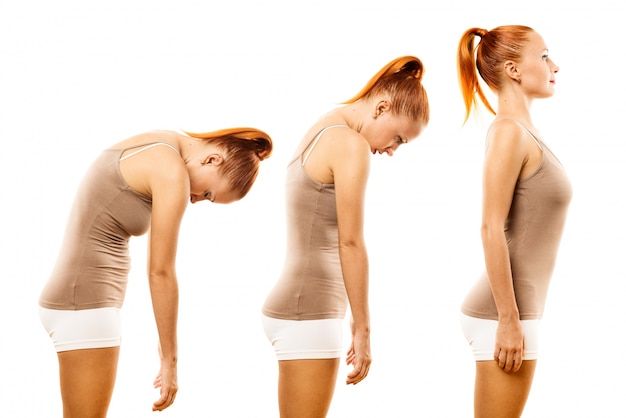
You’ve probably noticed some older adults with a slouched posture, where their back is rounded, and their shoulders lean forward. This condition is called kyphosis, though it used to be referred to as “dowager’s hump” since it was often associated with older women. However, kyphosis can affect people of all ages and genders. Spending long hours hunched over phones or desks can increase the risk.
If you have kyphosis, the most obvious sign is a hunched or rounded back. You might also feel pain in your neck or upper back, especially after sitting or standing for extended periods. As the curve progresses, it can limit your ability to bend or twist comfortably.
### What causes kyphosis?
Kyphosis happens when the muscles in your upper back and neck are weak, while your neck and chest muscles are tight. Several factors can increase the risk:
– **Osteoporosis:** This condition weakens bones and can cause compression or collapse of the vertebrae, leading to a curved spine. Women, especially after menopause, are more prone to this due to bone density loss.
– **Poor posture:** Slouching or leaning forward over time stresses your spine, particularly if you spend long periods sitting or standing.
– **Aging:** As we age, bones may lose density, muscles may weaken, and connective tissue can become less elastic. Age-related changes in the spine can make someone more likely to develop kyphosis, especially after age 50.
– **Lifestyle factors:** A sedentary lifestyle, smoking, and poor nutrition can also make kyphosis more likely.
– **Other conditions:** Certain bone or ligament disorders, as well as congenital medical issues, can increase your risk of developing kyphosis.
### Can kyphosis be reversed?
The possibility of reversing kyphosis depends on its underlying cause, how severe it is, and how promptly treatment begins. Early targeted treatment can make a big difference in stopping or even reversing the progression of the curve. Mild cases caused by poor posture are generally more manageable than severe cases linked to osteoporosis or spinal damage. Treatment can help improve posture, ease pain, increase flexibility, and enhance mobility for day-to-day activities.
### Treatment options
– **Improve your posture:** Learning proper ergonomics can help keep your spine aligned and reduce strain during daily tasks.
– **Strengthen your spine:** Building strength in your back, shoulders, and core muscles can counteract the curvature.
– **Work with a physical therapist:** Physical therapy can help balance muscles, improve flexibility, and align the spine. It also helps reduce pain and improve mobility.
– **Manage osteoporosis:** Medications like bisphosphonates and SERMs, along with calcium and vitamin D, can help manage bone loss. Your doctor can provide specific recommendations.
– **Consider alternative therapies:** Techniques like chiropractic care and acupuncture may provide relief by addressing spinal alignment and reducing pain. Always consult your healthcare provider before starting alternative treatments.
– **Surgery for severe cases:** If non-invasive treatments don’t help, or if you have significant pain, spinal instability, or neurological issues, surgery may be necessary. Procedures like vertebroplasty (injecting bone cement for support) or kyphoplasty (restoring spinal alignment using a balloon before securing it with bone cement) may be recommended.
### Helpful exercises for kyphosis
Certain exercises can strengthen your muscles and improve posture. If you’re unsure how to do these, consult a physical therapist.
– **Chin tucks:** Sit or stand with your back straight. Look straight ahead and gently pull your head back, as though making a double chin. You should feel the muscles at the front of your neck working. Hold for five to six seconds, then relax. Repeat 12 to 15 times.
– **Shoulder blade squeezes:** Sit or stand with your back straight and arms at your sides. Squeeze your shoulder blades together and hold for five to six seconds, then relax. Repeat 12 to 15 times.
– **Doorway stretches:** Stand about one to two feet in front of a doorway. Place your forearms on either side of the doorway with your elbows bent and your upper arms parallel to the floor. Step one foot forward into the doorway until you feel a stretch in your chest. Hold for 20 to 30 seconds and repeat three to five times.
### Tips for preventing kyphosis
Adopting healthy habits can reduce your risk of developing kyphosis and support overall spinal health:
– **Maintain good posture:** Keep your shoulders back, spine neutral, and chin parallel to the floor, whether you’re sitting, standing, or walking.
– **Adjust your workspace:** Use a supportive chair or lumbar cushion and position your computer monitor so it’s at eye level. Take regular breaks to stretch and move.
– **Use your smartphone wisely:** Hold your phone at eye level to avoid craning your neck downward.
– **Stay active:** Aim for at least 30 minutes of moderate-intensity activity most days. Include strength-focused exercises like yoga, Pilates, or weightlifting to keep your back, shoulders, and core strong.
– **Eat for bone health:** Choose foods rich in calcium (like dairy, leafy greens, and fortified cereals) and vitamin D (like fatty fish, eggs, and fortified dairy). Avoid excess processed foods, sugary drinks, and high caffeine intake, which can harm bone health.
### The bottom line
Kyphosis, also known as a “hunched back,” is often associated with older women but can affect anyone. Practicing good posture and strengthening key muscles can help prevent or improve this condition. With early intervention and the right treatment, you can reduce discomfort and improve your quality of life.